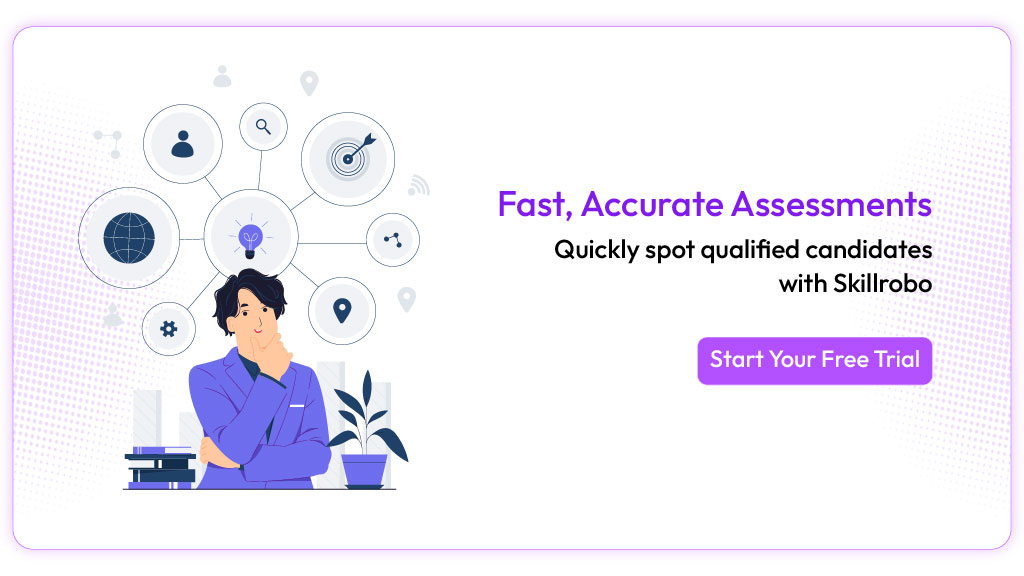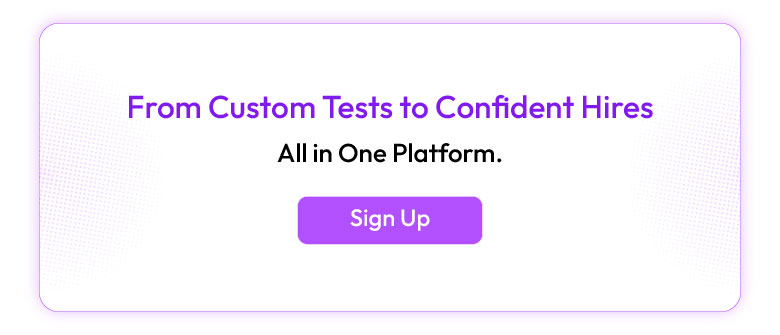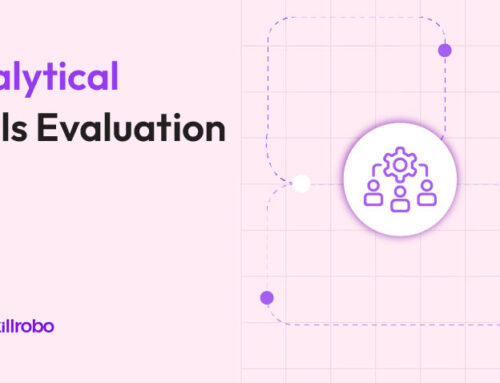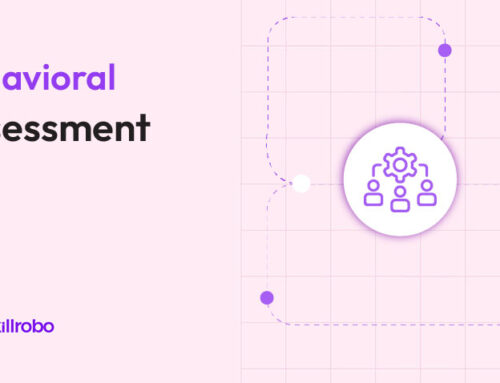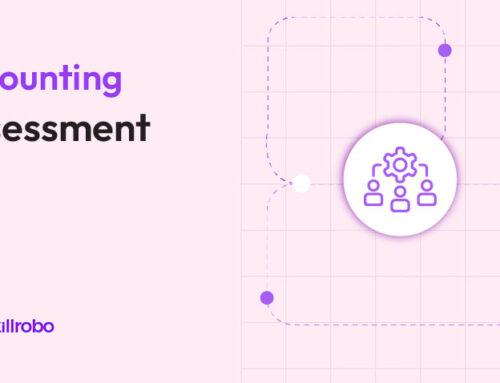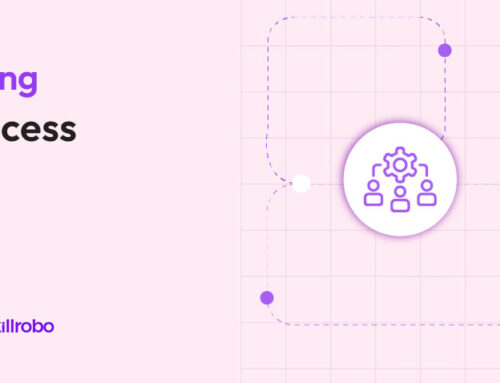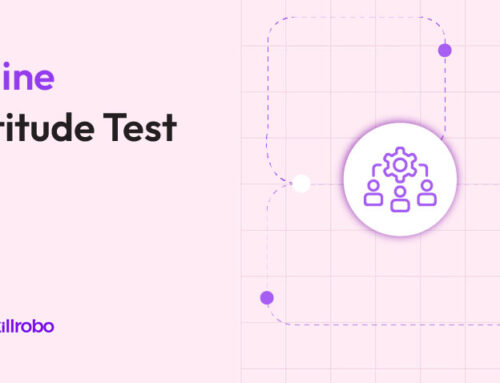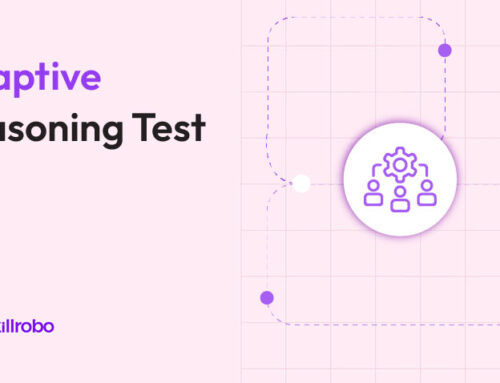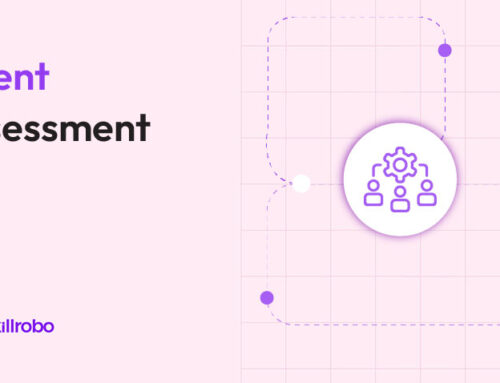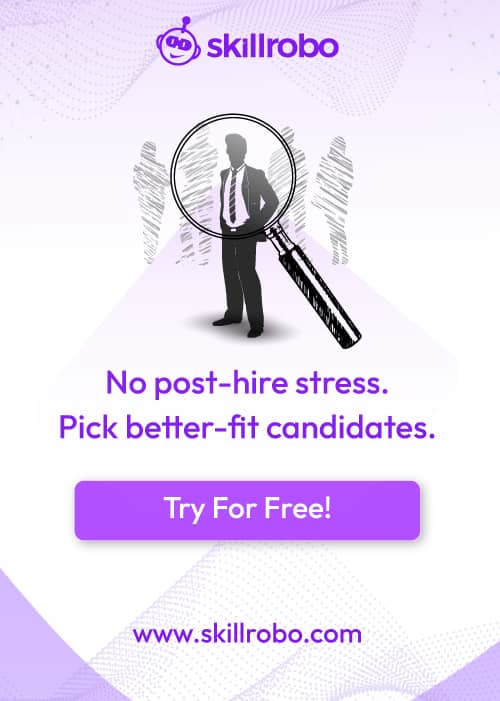Table of Contents
Related articles
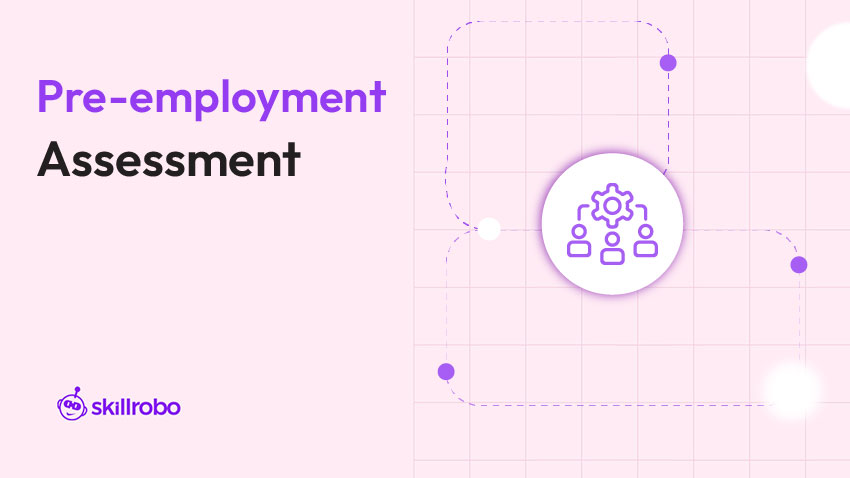
Key Takeaways
-
Pre-employment assessments enhance hiring accuracy by evaluating a candidate’s skills, behavior, and cognitive abilities, providing objective insights that resumes and interviews alone often miss.
-
Using the right type of test for each role helps organizations identify top talent, reduce turnover, and improve long-term employee performance across various departments.
-
Proper implementation and validation of assessment tools enhance fairness, legal defensibility, and hiring consistency while also improving candidate experience and employer branding.
-
Skillrobo empowers recruiters with customizable, AI-driven assessments that streamline test creation, automate scoring, and simplify the entire hiring workflow from screening to shortlisting.
Finding the ideal candidate for a position can be challenging, and conventional hiring practices are frequently unreliable. The top candidates for a position are found by using objective data from pre-employment assessments. When hiring, several businesses employ graphology. However, graphology isn’t any more accurate in predicting work performance than oracles or star signs.
Pre-employment assessment can aid employers in making better hiring decisions as long as they don’t rely on pseudoscience. Every organization should include talent screening tests. A well-designed test can reveal a lot about a candidate’s suitability and fit. However, the wrong test can degrade the candidate’s experience and hinder the employer’s hiring decision.
All of the candidates will be subjected to the same pre-employment tests. Employers use these assessments to evaluate the candidate’s knowledge, skills, and behavior. They assist employers in calculating their level of proficiency in the areas most important to the vacant position. They also score them according to the same scale so that employers can see who performs best when compared to the rest. In this article, we’ll explore what pre-employment assessment tests are, why organizations practice assessment tests, and the types of hiring assessment tests.
What are Pre-Employment Assessments?
Pre-employment assessments are a standardized, objective way to learn more about candidates during the hiring process. Pre-employment assessment tests that have been expertly produced and verified can quickly and accurately reveal insightful information about a candidate’s job-related talents, improving the chances of making a successful hiring. During the employment process, this centralized technique will be used to gather and record information about the candidate. Numerous assessments and screenings can provide information about the potential for effective task performance in the workplace.
Pre-employment assessments are quite effective and helpful in forecasting future performance. The typical job position may generate more than 250 applications in today’s job market. While everything is going on, job seekers decide whether or not to apply in as little as 14 seconds after reading the job description. Additionally, hiring managers themselves only give each CV an average of six to seven seconds of attention. Recruiters evaluate potential applicants using a variety of hiring assessment test methods, including pre-employment assessment tests, to determine which ones are the greatest fits for their organization.
These assessments allow employers to as objectively as possible collect data on candidates that is pertinent, trustworthy, and related to the position. The majority of pre-employment assessment tests are done online, and there are many different types of tests available. The primary purpose of these tests is to examine the candidate’s personality traits, cognitive abilities, job knowledge, skills, as well as behaviors.
The extensive insights from these assessments help recruiters make better hiring decisions. The pre-employment assessment test can be of great use to businesses looking for the best in this context. Organizations may improve their talent decisions and acquire a stronger talent signal by including these assessment tests for hiring in the candidate selection process.
Why do Organizations Use Pre-Employment Assessment Tests?
Employers must always try to learn as much information about their prospects during the hiring process. The issue is that conventional techniques of screening candidates’ resumes and interviews frequently fail to provide the most useful information. The most common lies on resumes concerning education and years of experience, and 72% of people acknowledge doing so.
Similar to assessments, interviews, particularly unstructured ones, are subjective and ultimately poor indicators of job performance. A reliable and impartial way to learn about candidates for a position is to use pre-employment exams that have been properly prepared and validated. Pre-employment assessments add objectivity to the hiring process by giving clear results that can be applied uniformly to all candidates. Then, with this data, employers may make more sensible, well-informed hiring decisions.
Businesses that implement pre-employment assessments can see real improvements in their bottom line. The two most frequent hiring-related issues for HR professionals and business owners are that organizations spend a lot more time on hiring than they expected. Despite this, they still make more hiring mistakes than they can afford. The pre-employment testing for human resources can directly address both of these issues by lowering the time and costs associated with hiring by drastically reducing the time spent reading resumes and holding interviews. Additionally, testing should improve hiring quality and decrease the number of unqualified candidates by giving accurate, objective data and predicting job performance.
Pre-employment assessments can assist employers in many ways, including
1. Evaluating the applicant’s skills
Employers administer pre-employment exams to see whether the talents match those listed in the job description. For example, a company hiring for a copywriter position might give the applicant a writing test to see whether the ability matches what they are looking for. If an employer hires someone who succeeds on a skills test because it demonstrates how a candidate can use their knowledge, that reduces the company’s turnover rate.
2. To enhance the interview’s quality
Employers can utilize these employee test screenings for recruitment results to ask candidates specific questions about their talents and work experience if they have enough data about the applicants.
3. To streamline the hiring process
These tests for hiring employees may be used by employers to swiftly reduce the pool of candidates they are considering hiring, particularly if they have a large number of resumes to look through.
Ways to Utilize the Pre-Employment Assessment Test
Pre-employment screening is frequently a part of the hiring process, and the exact timing of the screening will depend on the requirements and preferences of the employer. Recruiters sometimes decide to conduct tests for employment before the initial interview round as part of the application process. In some situations, companies could decide to hire candidates while deciding to hire candidates during a later stage in the hiring process, such as after the first or second round of interviews. The most crucial thing is to make sure the testing is conducted at a stage of the process when it will offer helpful and pertinent information to help in the employment selection.
Pre-hire assessment tests are frequently employed as early-stage screening tools, assisting in the development of a high-quality shortlist. This is particularly true for high-volume hiring processes like graduate programs, where applicants are tested for employment right away. Only qualified candidates move on to the next stage of the hiring process after the results of these selection tests for hiring are utilized to minimize the number of applicants. Additionally, with fewer candidates needing interviews, everyone can save time and effort.
Also Read: Best pre-employment assessment tools
15 Types of Pre-Employment Assessment Tests
1. Job knowledge tests
Recruiters conduct job knowledge tests, which candidates must pass to demonstrate a specified level of knowledge before starting a new position. Employers administer job knowledge tests to gauge the familiarity with the position they are applying for. A job knowledge test on the organization’s internal accounting procedures, for example, can be given if the prospective employer is employing a managerial accountant. It can be determined if they can use the knowledge they gained from prior accounting roles by testing for employment on specific work requirements.
2. Cognitive ability tests
Critical cognitive ability tests, like logical, language, and numerical thinking, are used for hiring employees and assist in estimating each applicant’s capacity to use mental processes. Employers can better estimate how well a candidate performs on the job based on the responses because employers have more knowledge about how a candidate will handle complexity.
3. Personality tests
Employers can tell if the candidate fits their culture by conducting personality tests, as well as determining if the candidate’s personality increases production. The findings of the test may aid employers in determining the level of involvement and whether they believe they have a long-term career interest in the company.
Candidates should review the various personality test formats and questions to better understand how to express their personality to employers. Although personality tests can measure a wide range of characteristics, the “Big Five”, also called the “Five Factor Model”, is the most well-known framework for personality assessments. These five personality traits, agreeableness, conscientiousness, extroversion, openness, and stress tolerance, regularly show up in empirical studies.
Some pre-employment personality tests that a candidate may also include:
- Caliper profile
- Myers-Briggs Type Indicator.
- Hagon Personality Inventory (HPI)
- DISC test.
4. Integrity tests
Integrity tests are among the most impartial tests that companies can use to evaluate an applicant’s dependability. Employers ask questions that are tailored to the level of morality and ethical guidance in the face of particular employment conditions. A candidate’s honesty might demonstrate that they fit the company’s culture and that they get along well with coworkers.
5. Emotional intelligence tests
Emotional intelligence tests evaluate the candidate’s capacity for forming bonds with others and understanding of emotions. High emotional intelligence demonstrates how a candidate can resolve problems and calm a teammate’s frustration or disappointment. Some employers might examine the emotional skill set using the Berke evaluation to see if it matches the position they are applying for. These skills are crucial in occupations that require a lot of leadership and interpersonal interaction. Emotional intelligence tests are often somewhat predictive of work performance.
The emotional intelligence test can reveal several abilities, including
- Teamwork: If a person can work well with coworkers from all backgrounds and personality types, they will prosper. Candidates have a better chance of achieving the objectives and being promoted to a high-level position by cooperating with the team.
- Empathy: Empathy is the ability to comprehend another person’s emotions in a certain circumstance. This quality demonstrates compassion and a willingness to support teammates in changing their perspectives and achieving their objectives.
- Adaptability: The ability to adapt will show how a candidate can modify to fulfill the demands of the organization at any given time. A project manager might have to rearrange the task priorities if a client requests that a project’s deadline be extended.
6. Physical ability tests
Physical ability tests focus on the candidate’s strength and endurance. They also demonstrate the ability to carry out jobs requiring physical labor, such as those of a police officer or firefighter. For employers, adding a physical competency test to the hiring process means they can locate qualified candidates while also lowering the risk of workplace accidents.
7. Skill assessment tests
Pre-employment skill testing provides an overview of both soft and hard skills. To determine who they might wish to recruit, employers test for these abilities later in the hiring process. A company might give a writing test, for instance, if they want to hire a candidate for a public relations manager to evaluate how quickly the candidate can type, whether they can produce newsworthy content in a set amount of time, and how effectively they proofread the work before submission. To move forward in the employment process, candidates would have to take additional skills tests where they’ll need to show off their research skills, presentation skills, and leadership skills.
8. Culture fit tests
In the cultural fit test, the candidate’s preferences for organizational culture are compared to the actual culture of the company they are applying to. This makes it easier for employers to see how an applicant’s values match those of the company.
9. Aptitude tests
Aptitude tests gauge a person’s capacity for critical thinking, problem-solving, and acquiring new skills. Essentially, cognitive aptitude tests measure a candidate’s general IQ or mental capacity. According to a survey, 63% of employers sought individuals with analytical skills, and 70% of employers sought candidates with problem-solving skills. Aptitude tests can be useful in this situation because it is challenging to evaluate these skills only based on resumes and interviews.
Nearly all occupational contexts can benefit from the use of aptitude tests, although mid and higher-level positions get the most from their use. It should come as no surprise that aptitude tests are among the most effective predictors of work performance since they are crucial to job performance across a wide range of industries. The General Aptitude Test (GAT), one of the popular cognitive ability tests, demonstrates the capacity for problem-solving through logical reasoning, verbal reasoning, and numerical reasoning. Candidates should take practice tests to familiarize themselves with possible test questions and solutions.
10. Verbal reasoning tests
Verbal reasoning tests are used to assess a person’s capacity for processing qualitative data, such as spoken and written words. A component of general cognitive capacity, which is the best indicator of work performance, is known as verbal reasoning. A variety of specific aptitudes, such as verbal reasoning, must be used to test general cognitive ability, as it cannot be directly assessed.
Verbal reasoning is one of the components of cognitive ability, and it may be the most significant in the workplace because the majority of the information given to employees daily is written or spoken. Verbal reasoning tests are among the most effective pre-employment proficiency tests, which are a predictor of performance, especially when used in conjunction with other aptitude tests.
11. Numerical reasoning tests
A person’s capacity to work with quantitative data, such as numbers and mathematical operators, is measured via numerical reasoning tests. When paired with other aptitude tests, numerical reasoning tests, a significant component of general cognitive ability, give an indirect measure of overall cognitive ability. In roles where employees must use data or analytics to make significant decisions, particularly in complicated technical, professional, and managerial responsibilities, numerical reasoning is extremely crucial. Numerical reasoning is one of the best indicators of task performance that is currently available as a pre-employment evaluation since it is strongly related to task performance (rather than contextual performance).
12. Situational judgment tests
Situational judgment tests (SJTs) are behavioral evaluations that test a candidate’s tendency for decision-making and the ability to reach rational decisions. They give candidates fictitious examples of real-world situations along with a variety of alternative solutions. The effectiveness of each line of action must then be ranked or rated, allowing candidates to demonstrate their decision-making skills.
As a result of their intent to forecast performance in very particular tasks, they, therefore, rank among the market’s most workplace-relevant assessments. SJTs can be used in conjunction with these tests to maximize their practical utility because research indicates they can predict performance better than ability tests and personality questionnaires.
13. Inductive reasoning tests
Inductive reasoning tests are used to gauge a person’s capacity for abstract problem-solving and logical thinking. Inductive reasoning is sometimes referred to as non-verbal reasoning, abstract reasoning, diagrammatic reasoning, or logical reasoning in cognitive ability tests. In professions requiring complex problem-solving, creativity, invention, or systems thinking, such as highly technical roles, inductive reasoning is particularly important.
Additionally, they have the advantage of being particularly language-free, which makes them an incredibly fair selection tool for evaluating applicants across several languages. When paired with other aptitude tests, inductive reasoning tests are frequently used as pre-employment screening tools to evaluate engineers or tech employees in general.
14. Soft skill tests
The non-technical abilities required for a profession, such as effective communication, problem-solving, teamwork, and honesty, are known as soft skills. If the job-specific activities can be learned over time, recruiters can evaluate prospects and hire those who have the proper soft skills.
15. Programming skills tests
Getting more technical, programming skills are increasingly essential for modern business and innovation. It makes it logical to include tests for each programming language and framework because they each have their own rules. Programming skills tests are designed to determine whether a candidate knows what is necessary for the position on a particular topic, much as tests of role-specific skills. These tests are usually combined with general tests.
Due to the complexity of the coding requirements, tests in the programming field often take longer than the standard 10 minutes. Questions and challenges typically include screenshots or visuals to assist the candidate in visualizing the subject at hand and might range from technical expertise to problem-solving. This kind of test is unavoidable for programmers’ pre-employment evaluations.
Key Benefits of Pre-Employment Assessment Tests
1. Improved Productivity:
Across a wide range of job types and industries, pre-employment tests can accurately predict employee productivity. These tests can unbiasedly ascertain to what extent a candidate possesses the knowledge, skills, and ability to perform well in any given profession; they are among the most reliable methods of forecasting performance. Employers can quickly compile candidate information into a single location where the team can examine, upload, and share job information using an online pre-employment testing system.
2. Increased efficiency
Managing applicant flow and finding the ideal prospects in a pool of resumes is becoming more and more challenging for recruiters as applicant pools expand quickly. Pre-employment tests can greatly speed up the hiring process if they are included in it. When given at the beginning of the hiring process, pre-employment tests have the greatest potential for time savings.
Companies are clearing out many of the “resume spammers” who send out their resumes with little thought or effort by mandating that applicants complete the tests early on. The candidates who ultimately pass the tests are, at the very least, interested in the position enough to invest the time necessary to complete the tests.
Setting minimum cutoff scores for some tests can also help quickly reduce the pool of candidates for phone or in-person interviews. The total amount of time spent hiring staff is significantly decreased by cutting down on the interview procedure. Pre-employment assessment tests make it simpler to identify the individuals who have the best chance of succeeding on the job, which cuts down on the amount of time spent on time-consuming recruiting activities.
3. Reduced employee turnover
Pre-employment testing can improve employee retention by ensuring that new hires have the fundamental skills needed for the position, as well as the right personality to feel at ease doing the kind of work demanded of them. These elements may lessen the possibility that employees will leave on their initiative and that they will be fired for performing poorly or failing to complete training.
Wide-ranging advantages that spread throughout the whole organization can be achieved by reducing turnover. Lower turnover rates improve employee morale and enhance a business’s standing with the public, which in turn makes it simpler for a business to find and hire applicants of higher quality. Additionally, lowering turnover has more obvious advantages for a company’s objectives. Recruitment, selection, training, and possibly severance pay for the departing employee are some of the costs related to replacing an employee.
4. Simplified hiring procedure
Pre-employment testing software has several notable advantages, one of which is improved recruitment efficiency. Recruiters may learn a lot about a lot of job candidates with the help of the proper screening software in a lot less time than it takes to manually go through resumes.
5. Enhanced defensibility
Pre-employment testing can improve an organization’s selection process objectivity, equity, and legal defensibility in addition to helping the company in realizing gains in various business results. Employer selection and promotion should be fair and compatible with the law in all businesses. Federal regulations that aim to promote fair and non-discriminatory hiring practices extend to pre-employment testing. Due to this, several businesses feel that using employment tests increases their legal liability. However, these tests and any other selection techniques employed by recruiters are governed by the same rule.
6. Boosted the caliber of hiring
Pre-employment evaluations aid employers in selecting applicants who are most suitable for the position and the company. This is an exciting development for the hiring manager as well as improving the quality of hires in general.
7. Improved candidate experience
Pre-employment assessment tests can also benefit applicants. They enable job seekers to discover more about the organization they are interested in while also discovering more about themselves. This improves the hiring process for candidates and makes sure they get into a position for which they are a perfect fit.
8. Removed hiring bias
Recruiters are entrusted with minimizing unconscious bias because it is a significant issue in hiring. Pre-employment screening reduces hiring discrimination by focusing on candidates’ relevant talents and personality attributes rather than just their background or ethnicity.
9. Allowed for easy customization
Using a unique pre-work assessment test generator, employers may create their industry-specific questions or select from prebuilt questions in a variety of topics to customize tests for a particular role.
10. Cost-effective
Online pre-employment test administration takes less time than administering and scoring paper-and-pencil tests, which results in lower labor and material costs.
11. Enhanced security
Preventing unauthorized access to test materials and guaranteeing the confidentiality of test results are two ways that online pre-employment testing software can help maintain the integrity of the testing process.
Best Practices of Pre-Employment Assessment
1. Research the providers
Researching the many providers that are accessible is one of the most important things an employer can do to start pre-employment screening at the organization. Many different companies out there offer various pre-employment testing examples in different formats. Learn about the services they provide and ask pertinent questions, like
- What kind of tests are given before employment?
- Are the given tests customizable?
- How is the onboarding process?
- What kind of customer service is offered?
Employers can be sure that they’ll select the greatest solution to suit the company’s needs by asking these questions and learning as much as they can about the program they’re considering purchasing.
2. Verify the validity of the data
The data from pre-employment testing is validated using a wide variety of validity metrics. For example, when the performance and job description are in line with the evaluation’s criteria, it shows content. Another example of criterion-related validity is when a pre-employment test’s results can be used to forecast employee performance. This necessitates statistical analysis and comparison of evaluation results to employee performance. Pre-employment tests can also show construct validity, which is assessed by contrasting the outcomes with another test assessing the same psychological construct, such as integrity or intelligence.
3. Implement testing
The selection of tests is crucial when performing pre-employment testing. To ensure that the traits the employer chooses are indicative of success on the job, make sure they are the most suited for measuring the relevant talents and traits for the job in question. Choosing a test that isn’t a good fit can produce findings that are useless for choosing candidates. Also, employers should ensure that to perform the right number of tests. According to studies, tests that are finished in less than 40 minutes have a 75% completion rate. On the other hand, just 66% of tests that last between 41 minutes and an hour are completed. They can reduce the number of applicants who drop out of the process due to time constraints by keeping tests to 40 minutes or less.
4. Pre-employment testing should reflect the brand
It’s usually a good idea to make the pre-employment testing as branded-consistent with the company as they can. Utilizing this testing software with customization options will allow employers to market the business in a variety of ways. For example, recruiters can use the color scheme or upload the company’s logo to keep the website and social media platforms consistent with the branding. To make the assessment more engaging, some businesses include team pictures or videos. These actions not only improve the pre-employment testing process for applicants but also provide them with an insight into the workplace environment and the position they are seeking.
5. Monitor the testing completion rate
Monitoring the testing completion rates will also help employers determine when and where candidates stop taking the test. This will give them time to consider how they might make the process better, for example, by shortening or rearranging the pre-hire tests. Recruiters may optimize the process and make improvements to it to make their pre-employment testing even more beneficial over time by keeping track of completion rates.
6. Utilize the test results
Pre-hire evaluation should only be used as a starting point for the decision-making process. They are not intended to be the final decisions. Don’t make the decision based only on a candidate’s test results. To ensure that the employer makes a completely informed, unbiased judgment, combine the pre-employment testing with other candidate selection techniques like job interviews, test assignments, or trial days.
How to Choose the Best Pre-Employment Test
Businesses must use tests that gauge abilities and skills relevant to the job at hand; therefore, test selection is the first and most crucial stage in putting a pre-employment test strategy into place. Tests are no exception to the so-called rule of “job-relatedness”, which states that pre-hire assessments must assess traits, skills, and talents that are pertinent to the position under consideration.
A testing program that does not comply with the law as a result of improper test selection will have a negative impact. That is why it is a standard best practice in employment testing to perform a job requirements analysis for a position before utilizing the tests to screen applicants. Tests that measure general abilities, such as those that assess critical thinking, problem-solving, and learning ability, are likely to be “job-relevant” for many different roles since they measure skills that are important for almost all job kinds. Other tests, such as a customer support personality test, that were created expressly for a role should never be utilized for one for which they were not intended.
Finally, it is often desirable to select unique testing methodologies for each position because the majority of organizations hire for several positions with vastly divergent job requirements. Although there will frequently be shared components among test kits for various positions. For instance, it may be appropriate to use a general aptitude test for a variety of positions, making test selection decisions based on the specific requirements of each position is generally the best way to ensure adherence to the rule of job-relatedness.
Conclusion
Selecting the appropriate test types for the upcoming Skillrobo pre-employment assessment can mean the difference between hiring someone who will contribute to the company for many years and someone who will cause the rest of the team to grind to a halt. Utilizing various test formats aims to acquire in-depth candidate insights and let them make decisions based on information rather than emotion.
Consider integrating a variety of tests in the next evaluation when making the recruitment test selection. It’s common to undervalue soft skills, especially if the position is technical, but learning about a candidate’s professional motives will help them make recruiting judgments much more quickly. Pre-employment testing can greatly aid the hiring process if it is properly implemented, carried out, and assessed. Employers can get started by looking into various hiring test types and determining which ones apply to the positions they’re hiring for.
When choosing pre-employment assessment tools, consider essential features such as advanced search capabilities, integration capabilities, and data analytics. Skillrobo is the best among all in the above-mentioned list.
The setup and administration of tests are made simpler by its intuitive interface. Recruiters can alter the test’s duration, difficulty level, and the particular technical domains that will be evaluated to suit their needs.
Click here to sign up.

Key Takeaways
-
Pre-employment assessments enhance hiring accuracy by evaluating a candidate’s skills, behavior, and cognitive abilities, providing objective insights that resumes and interviews alone often miss.
-
Using the right type of test for each role helps organizations identify top talent, reduce turnover, and improve long-term employee performance across various departments.
-
Proper implementation and validation of assessment tools enhance fairness, legal defensibility, and hiring consistency while also improving candidate experience and employer branding.
-
Skillrobo empowers recruiters with customizable, AI-driven assessments that streamline test creation, automate scoring, and simplify the entire hiring workflow from screening to shortlisting.
Finding the ideal candidate for a position can be challenging, and conventional hiring practices are frequently unreliable. The top candidates for a position are found by using objective data from pre-employment assessments. When hiring, several businesses employ graphology. However, graphology isn’t any more accurate in predicting work performance than oracles or star signs.
Pre-employment assessment can aid employers in making better hiring decisions as long as they don’t rely on pseudoscience. Every organization should include talent screening tests. A well-designed test can reveal a lot about a candidate’s suitability and fit. However, the wrong test can degrade the candidate’s experience and hinder the employer’s hiring decision.
All of the candidates will be subjected to the same pre-employment tests. Employers use these assessments to evaluate the candidate’s knowledge, skills, and behavior. They assist employers in calculating their level of proficiency in the areas most important to the vacant position. They also score them according to the same scale so that employers can see who performs best when compared to the rest. In this article, we’ll explore what pre-employment assessment tests are, why organizations practice assessment tests, and the types of hiring assessment tests.
What are Pre-Employment Assessments?
Pre-employment assessments are a standardized, objective way to learn more about candidates during the hiring process. Pre-employment assessment tests that have been expertly produced and verified can quickly and accurately reveal insightful information about a candidate’s job-related talents, improving the chances of making a successful hiring. During the employment process, this centralized technique will be used to gather and record information about the candidate. Numerous assessments and screenings can provide information about the potential for effective task performance in the workplace.
Pre-employment assessments are quite effective and helpful in forecasting future performance. The typical job position may generate more than 250 applications in today’s job market. While everything is going on, job seekers decide whether or not to apply in as little as 14 seconds after reading the job description. Additionally, hiring managers themselves only give each CV an average of six to seven seconds of attention. Recruiters evaluate potential applicants using a variety of hiring assessment test methods, including pre-employment assessment tests, to determine which ones are the greatest fits for their organization.
These assessments allow employers to as objectively as possible collect data on candidates that is pertinent, trustworthy, and related to the position. The majority of pre-employment assessment tests are done online, and there are many different types of tests available. The primary purpose of these tests is to examine the candidate’s personality traits, cognitive abilities, job knowledge, skills, as well as behaviors.
The extensive insights from these assessments help recruiters make better hiring decisions. The pre-employment assessment test can be of great use to businesses looking for the best in this context. Organizations may improve their talent decisions and acquire a stronger talent signal by including these assessment tests for hiring in the candidate selection process.
Why do Organizations Use Pre-Employment Assessment Tests?
Employers must always try to learn as much information about their prospects during the hiring process. The issue is that conventional techniques of screening candidates’ resumes and interviews frequently fail to provide the most useful information. The most common lies on resumes concerning education and years of experience, and 72% of people acknowledge doing so.
Similar to assessments, interviews, particularly unstructured ones, are subjective and ultimately poor indicators of job performance. A reliable and impartial way to learn about candidates for a position is to use pre-employment exams that have been properly prepared and validated. Pre-employment assessments add objectivity to the hiring process by giving clear results that can be applied uniformly to all candidates. Then, with this data, employers may make more sensible, well-informed hiring decisions.
Businesses that implement pre-employment assessments can see real improvements in their bottom line. The two most frequent hiring-related issues for HR professionals and business owners are that organizations spend a lot more time on hiring than they expected. Despite this, they still make more hiring mistakes than they can afford. The pre-employment testing for human resources can directly address both of these issues by lowering the time and costs associated with hiring by drastically reducing the time spent reading resumes and holding interviews. Additionally, testing should improve hiring quality and decrease the number of unqualified candidates by giving accurate, objective data and predicting job performance.
Pre-employment assessments can assist employers in many ways, including
1. Evaluating the applicant’s skills
Employers administer pre-employment exams to see whether the talents match those listed in the job description. For example, a company hiring for a copywriter position might give the applicant a writing test to see whether the ability matches what they are looking for. If an employer hires someone who succeeds on a skills test because it demonstrates how a candidate can use their knowledge, that reduces the company’s turnover rate.
2. To enhance the interview’s quality
Employers can utilize these employee test screenings for recruitment results to ask candidates specific questions about their talents and work experience if they have enough data about the applicants.
3. To streamline the hiring process
These tests for hiring employees may be used by employers to swiftly reduce the pool of candidates they are considering hiring, particularly if they have a large number of resumes to look through.
Ways to Utilize the Pre-Employment Assessment Test
Pre-employment screening is frequently a part of the hiring process, and the exact timing of the screening will depend on the requirements and preferences of the employer. Recruiters sometimes decide to conduct tests for employment before the initial interview round as part of the application process. In some situations, companies could decide to hire candidates while deciding to hire candidates during a later stage in the hiring process, such as after the first or second round of interviews. The most crucial thing is to make sure the testing is conducted at a stage of the process when it will offer helpful and pertinent information to help in the employment selection.
Pre-hire assessment tests are frequently employed as early-stage screening tools, assisting in the development of a high-quality shortlist. This is particularly true for high-volume hiring processes like graduate programs, where applicants are tested for employment right away. Only qualified candidates move on to the next stage of the hiring process after the results of these selection tests for hiring are utilized to minimize the number of applicants. Additionally, with fewer candidates needing interviews, everyone can save time and effort.
Also Read: Best pre-employment assessment tools
15 Types of Pre-Employment Assessment Tests
1. Job knowledge tests
Recruiters conduct job knowledge tests, which candidates must pass to demonstrate a specified level of knowledge before starting a new position. Employers administer job knowledge tests to gauge the familiarity with the position they are applying for. A job knowledge test on the organization’s internal accounting procedures, for example, can be given if the prospective employer is employing a managerial accountant. It can be determined if they can use the knowledge they gained from prior accounting roles by testing for employment on specific work requirements.
2. Cognitive ability tests
Critical cognitive ability tests, like logical, language, and numerical thinking, are used for hiring employees and assist in estimating each applicant’s capacity to use mental processes. Employers can better estimate how well a candidate performs on the job based on the responses because employers have more knowledge about how a candidate will handle complexity.
3. Personality tests
Employers can tell if the candidate fits their culture by conducting personality tests, as well as determining if the candidate’s personality increases production. The findings of the test may aid employers in determining the level of involvement and whether they believe they have a long-term career interest in the company.
Candidates should review the various personality test formats and questions to better understand how to express their personality to employers. Although personality tests can measure a wide range of characteristics, the “Big Five”, also called the “Five Factor Model”, is the most well-known framework for personality assessments. These five personality traits, agreeableness, conscientiousness, extroversion, openness, and stress tolerance, regularly show up in empirical studies.
Some pre-employment personality tests that a candidate may also include:
- Caliper profile
- Myers-Briggs Type Indicator.
- Hagon Personality Inventory (HPI)
- DISC test.
4. Integrity tests
Integrity tests are among the most impartial tests that companies can use to evaluate an applicant’s dependability. Employers ask questions that are tailored to the level of morality and ethical guidance in the face of particular employment conditions. A candidate’s honesty might demonstrate that they fit the company’s culture and that they get along well with coworkers.
5. Emotional intelligence tests
Emotional intelligence tests evaluate the candidate’s capacity for forming bonds with others and understanding of emotions. High emotional intelligence demonstrates how a candidate can resolve problems and calm a teammate’s frustration or disappointment. Some employers might examine the emotional skill set using the Berke evaluation to see if it matches the position they are applying for. These skills are crucial in occupations that require a lot of leadership and interpersonal interaction. Emotional intelligence tests are often somewhat predictive of work performance.
The emotional intelligence test can reveal several abilities, including
- Teamwork: If a person can work well with coworkers from all backgrounds and personality types, they will prosper. Candidates have a better chance of achieving the objectives and being promoted to a high-level position by cooperating with the team.
- Empathy: Empathy is the ability to comprehend another person’s emotions in a certain circumstance. This quality demonstrates compassion and a willingness to support teammates in changing their perspectives and achieving their objectives.
- Adaptability: The ability to adapt will show how a candidate can modify to fulfill the demands of the organization at any given time. A project manager might have to rearrange the task priorities if a client requests that a project’s deadline be extended.
6. Physical ability tests
Physical ability tests focus on the candidate’s strength and endurance. They also demonstrate the ability to carry out jobs requiring physical labor, such as those of a police officer or firefighter. For employers, adding a physical competency test to the hiring process means they can locate qualified candidates while also lowering the risk of workplace accidents.
7. Skill assessment tests
Pre-employment skill testing provides an overview of both soft and hard skills. To determine who they might wish to recruit, employers test for these abilities later in the hiring process. A company might give a writing test, for instance, if they want to hire a candidate for a public relations manager to evaluate how quickly the candidate can type, whether they can produce newsworthy content in a set amount of time, and how effectively they proofread the work before submission. To move forward in the employment process, candidates would have to take additional skills tests where they’ll need to show off their research skills, presentation skills, and leadership skills.
8. Culture fit tests
In the cultural fit test, the candidate’s preferences for organizational culture are compared to the actual culture of the company they are applying to. This makes it easier for employers to see how an applicant’s values match those of the company.
9. Aptitude tests
Aptitude tests gauge a person’s capacity for critical thinking, problem-solving, and acquiring new skills. Essentially, cognitive aptitude tests measure a candidate’s general IQ or mental capacity. According to a survey, 63% of employers sought individuals with analytical skills, and 70% of employers sought candidates with problem-solving skills. Aptitude tests can be useful in this situation because it is challenging to evaluate these skills only based on resumes and interviews.
Nearly all occupational contexts can benefit from the use of aptitude tests, although mid and higher-level positions get the most from their use. It should come as no surprise that aptitude tests are among the most effective predictors of work performance since they are crucial to job performance across a wide range of industries. The General Aptitude Test (GAT), one of the popular cognitive ability tests, demonstrates the capacity for problem-solving through logical reasoning, verbal reasoning, and numerical reasoning. Candidates should take practice tests to familiarize themselves with possible test questions and solutions.
10. Verbal reasoning tests
Verbal reasoning tests are used to assess a person’s capacity for processing qualitative data, such as spoken and written words. A component of general cognitive capacity, which is the best indicator of work performance, is known as verbal reasoning. A variety of specific aptitudes, such as verbal reasoning, must be used to test general cognitive ability, as it cannot be directly assessed.
Verbal reasoning is one of the components of cognitive ability, and it may be the most significant in the workplace because the majority of the information given to employees daily is written or spoken. Verbal reasoning tests are among the most effective pre-employment proficiency tests, which are a predictor of performance, especially when used in conjunction with other aptitude tests.
11. Numerical reasoning tests
A person’s capacity to work with quantitative data, such as numbers and mathematical operators, is measured via numerical reasoning tests. When paired with other aptitude tests, numerical reasoning tests, a significant component of general cognitive ability, give an indirect measure of overall cognitive ability. In roles where employees must use data or analytics to make significant decisions, particularly in complicated technical, professional, and managerial responsibilities, numerical reasoning is extremely crucial. Numerical reasoning is one of the best indicators of task performance that is currently available as a pre-employment evaluation since it is strongly related to task performance (rather than contextual performance).
12. Situational judgment tests
Situational judgment tests (SJTs) are behavioral evaluations that test a candidate’s tendency for decision-making and the ability to reach rational decisions. They give candidates fictitious examples of real-world situations along with a variety of alternative solutions. The effectiveness of each line of action must then be ranked or rated, allowing candidates to demonstrate their decision-making skills.
As a result of their intent to forecast performance in very particular tasks, they, therefore, rank among the market’s most workplace-relevant assessments. SJTs can be used in conjunction with these tests to maximize their practical utility because research indicates they can predict performance better than ability tests and personality questionnaires.
13. Inductive reasoning tests
Inductive reasoning tests are used to gauge a person’s capacity for abstract problem-solving and logical thinking. Inductive reasoning is sometimes referred to as non-verbal reasoning, abstract reasoning, diagrammatic reasoning, or logical reasoning in cognitive ability tests. In professions requiring complex problem-solving, creativity, invention, or systems thinking, such as highly technical roles, inductive reasoning is particularly important.
Additionally, they have the advantage of being particularly language-free, which makes them an incredibly fair selection tool for evaluating applicants across several languages. When paired with other aptitude tests, inductive reasoning tests are frequently used as pre-employment screening tools to evaluate engineers or tech employees in general.
14. Soft skill tests
The non-technical abilities required for a profession, such as effective communication, problem-solving, teamwork, and honesty, are known as soft skills. If the job-specific activities can be learned over time, recruiters can evaluate prospects and hire those who have the proper soft skills.
15. Programming skills tests
Getting more technical, programming skills are increasingly essential for modern business and innovation. It makes it logical to include tests for each programming language and framework because they each have their own rules. Programming skills tests are designed to determine whether a candidate knows what is necessary for the position on a particular topic, much as tests of role-specific skills. These tests are usually combined with general tests.
Due to the complexity of the coding requirements, tests in the programming field often take longer than the standard 10 minutes. Questions and challenges typically include screenshots or visuals to assist the candidate in visualizing the subject at hand and might range from technical expertise to problem-solving. This kind of test is unavoidable for programmers’ pre-employment evaluations.
Key Benefits of Pre-Employment Assessment Tests
1. Improved Productivity:
Across a wide range of job types and industries, pre-employment tests can accurately predict employee productivity. These tests can unbiasedly ascertain to what extent a candidate possesses the knowledge, skills, and ability to perform well in any given profession; they are among the most reliable methods of forecasting performance. Employers can quickly compile candidate information into a single location where the team can examine, upload, and share job information using an online pre-employment testing system.
2. Increased efficiency
Managing applicant flow and finding the ideal prospects in a pool of resumes is becoming more and more challenging for recruiters as applicant pools expand quickly. Pre-employment tests can greatly speed up the hiring process if they are included in it. When given at the beginning of the hiring process, pre-employment tests have the greatest potential for time savings.
Companies are clearing out many of the “resume spammers” who send out their resumes with little thought or effort by mandating that applicants complete the tests early on. The candidates who ultimately pass the tests are, at the very least, interested in the position enough to invest the time necessary to complete the tests.
Setting minimum cutoff scores for some tests can also help quickly reduce the pool of candidates for phone or in-person interviews. The total amount of time spent hiring staff is significantly decreased by cutting down on the interview procedure. Pre-employment assessment tests make it simpler to identify the individuals who have the best chance of succeeding on the job, which cuts down on the amount of time spent on time-consuming recruiting activities.
3. Reduced employee turnover
Pre-employment testing can improve employee retention by ensuring that new hires have the fundamental skills needed for the position, as well as the right personality to feel at ease doing the kind of work demanded of them. These elements may lessen the possibility that employees will leave on their initiative and that they will be fired for performing poorly or failing to complete training.
Wide-ranging advantages that spread throughout the whole organization can be achieved by reducing turnover. Lower turnover rates improve employee morale and enhance a business’s standing with the public, which in turn makes it simpler for a business to find and hire applicants of higher quality. Additionally, lowering turnover has more obvious advantages for a company’s objectives. Recruitment, selection, training, and possibly severance pay for the departing employee are some of the costs related to replacing an employee.
4. Simplified hiring procedure
Pre-employment testing software has several notable advantages, one of which is improved recruitment efficiency. Recruiters may learn a lot about a lot of job candidates with the help of the proper screening software in a lot less time than it takes to manually go through resumes.
5. Enhanced defensibility
Pre-employment testing can improve an organization’s selection process objectivity, equity, and legal defensibility in addition to helping the company in realizing gains in various business results. Employer selection and promotion should be fair and compatible with the law in all businesses. Federal regulations that aim to promote fair and non-discriminatory hiring practices extend to pre-employment testing. Due to this, several businesses feel that using employment tests increases their legal liability. However, these tests and any other selection techniques employed by recruiters are governed by the same rule.
6. Boosted the caliber of hiring
Pre-employment evaluations aid employers in selecting applicants who are most suitable for the position and the company. This is an exciting development for the hiring manager as well as improving the quality of hires in general.
7. Improved candidate experience
Pre-employment assessment tests can also benefit applicants. They enable job seekers to discover more about the organization they are interested in while also discovering more about themselves. This improves the hiring process for candidates and makes sure they get into a position for which they are a perfect fit.
8. Removed hiring bias
Recruiters are entrusted with minimizing unconscious bias because it is a significant issue in hiring. Pre-employment screening reduces hiring discrimination by focusing on candidates’ relevant talents and personality attributes rather than just their background or ethnicity.
9. Allowed for easy customization
Using a unique pre-work assessment test generator, employers may create their industry-specific questions or select from prebuilt questions in a variety of topics to customize tests for a particular role.
10. Cost-effective
Online pre-employment test administration takes less time than administering and scoring paper-and-pencil tests, which results in lower labor and material costs.
11. Enhanced security
Preventing unauthorized access to test materials and guaranteeing the confidentiality of test results are two ways that online pre-employment testing software can help maintain the integrity of the testing process.
Best Practices of Pre-Employment Assessment
1. Research the providers
Researching the many providers that are accessible is one of the most important things an employer can do to start pre-employment screening at the organization. Many different companies out there offer various pre-employment testing examples in different formats. Learn about the services they provide and ask pertinent questions, like
- What kind of tests are given before employment?
- Are the given tests customizable?
- How is the onboarding process?
- What kind of customer service is offered?
Employers can be sure that they’ll select the greatest solution to suit the company’s needs by asking these questions and learning as much as they can about the program they’re considering purchasing.
2. Verify the validity of the data
The data from pre-employment testing is validated using a wide variety of validity metrics. For example, when the performance and job description are in line with the evaluation’s criteria, it shows content. Another example of criterion-related validity is when a pre-employment test’s results can be used to forecast employee performance. This necessitates statistical analysis and comparison of evaluation results to employee performance. Pre-employment tests can also show construct validity, which is assessed by contrasting the outcomes with another test assessing the same psychological construct, such as integrity or intelligence.
3. Implement testing
The selection of tests is crucial when performing pre-employment testing. To ensure that the traits the employer chooses are indicative of success on the job, make sure they are the most suited for measuring the relevant talents and traits for the job in question. Choosing a test that isn’t a good fit can produce findings that are useless for choosing candidates. Also, employers should ensure that to perform the right number of tests. According to studies, tests that are finished in less than 40 minutes have a 75% completion rate. On the other hand, just 66% of tests that last between 41 minutes and an hour are completed. They can reduce the number of applicants who drop out of the process due to time constraints by keeping tests to 40 minutes or less.
4. Pre-employment testing should reflect the brand
It’s usually a good idea to make the pre-employment testing as branded-consistent with the company as they can. Utilizing this testing software with customization options will allow employers to market the business in a variety of ways. For example, recruiters can use the color scheme or upload the company’s logo to keep the website and social media platforms consistent with the branding. To make the assessment more engaging, some businesses include team pictures or videos. These actions not only improve the pre-employment testing process for applicants but also provide them with an insight into the workplace environment and the position they are seeking.
5. Monitor the testing completion rate
Monitoring the testing completion rates will also help employers determine when and where candidates stop taking the test. This will give them time to consider how they might make the process better, for example, by shortening or rearranging the pre-hire tests. Recruiters may optimize the process and make improvements to it to make their pre-employment testing even more beneficial over time by keeping track of completion rates.
6. Utilize the test results
Pre-hire evaluation should only be used as a starting point for the decision-making process. They are not intended to be the final decisions. Don’t make the decision based only on a candidate’s test results. To ensure that the employer makes a completely informed, unbiased judgment, combine the pre-employment testing with other candidate selection techniques like job interviews, test assignments, or trial days.
How to Choose the Best Pre-Employment Test
Businesses must use tests that gauge abilities and skills relevant to the job at hand; therefore, test selection is the first and most crucial stage in putting a pre-employment test strategy into place. Tests are no exception to the so-called rule of “job-relatedness”, which states that pre-hire assessments must assess traits, skills, and talents that are pertinent to the position under consideration.
A testing program that does not comply with the law as a result of improper test selection will have a negative impact. That is why it is a standard best practice in employment testing to perform a job requirements analysis for a position before utilizing the tests to screen applicants. Tests that measure general abilities, such as those that assess critical thinking, problem-solving, and learning ability, are likely to be “job-relevant” for many different roles since they measure skills that are important for almost all job kinds. Other tests, such as a customer support personality test, that were created expressly for a role should never be utilized for one for which they were not intended.
Finally, it is often desirable to select unique testing methodologies for each position because the majority of organizations hire for several positions with vastly divergent job requirements. Although there will frequently be shared components among test kits for various positions. For instance, it may be appropriate to use a general aptitude test for a variety of positions, making test selection decisions based on the specific requirements of each position is generally the best way to ensure adherence to the rule of job-relatedness.
Conclusion
Selecting the appropriate test types for the upcoming Skillrobo pre-employment assessment can mean the difference between hiring someone who will contribute to the company for many years and someone who will cause the rest of the team to grind to a halt. Utilizing various test formats aims to acquire in-depth candidate insights and let them make decisions based on information rather than emotion.
Consider integrating a variety of tests in the next evaluation when making the recruitment test selection. It’s common to undervalue soft skills, especially if the position is technical, but learning about a candidate’s professional motives will help them make recruiting judgments much more quickly. Pre-employment testing can greatly aid the hiring process if it is properly implemented, carried out, and assessed. Employers can get started by looking into various hiring test types and determining which ones apply to the positions they’re hiring for.
When choosing pre-employment assessment tools, consider essential features such as advanced search capabilities, integration capabilities, and data analytics. Skillrobo is the best among all in the above-mentioned list.
The setup and administration of tests are made simpler by its intuitive interface. Recruiters can alter the test’s duration, difficulty level, and the particular technical domains that will be evaluated to suit their needs.
Click here to sign up.

